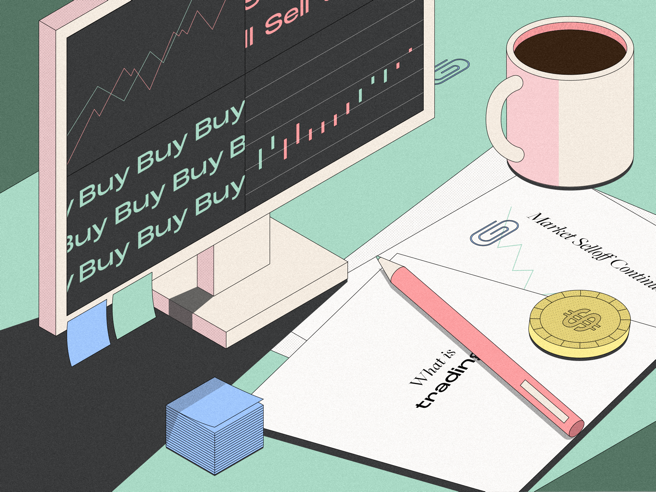Occasionally we’ll link out to relevant products that could be useful to our readers. Learn more about us here.
The exchange-traded fund (ETF) is another way for investors to get access to a diversified portfolio of stocks, bonds and other investments. Like a mutual fund, ETFs hold a collection of securities in one place. Unlike mutual funds, ETFs are bought and sold on stock exchanges, which means they always have a price (mutual fund units are only priced at the end of the day) and can be easily purchased at anytime of the day.
Since their debut in the early ’90s, ETFs have become a popular investment vehicle because of how easy they are to buy and sell, but they’re also much more transparent than mutual funds – you can see exactly what’s in an ETF – and they often come with lower management fees than other investment products.
Understanding the ETF
The ETF was born in Canada in 1990. While an attempt to launch an ETF-like product in the U.S. was made a year earlier, a court shut it down because it behaved too much like a futures contract and not enough like an equity product. A year later, the Toronto Stock Exchange launched the Toronto 35 Index Participation Fund (TIPs 35), a fund that allowed investors to shares in the 35 largest companies on the Toronto Stock Exchange without having to purchase their individual stocks.
Since then thousands of ETFs have come to market, many mimic a specific index and allow investors to buy into that index at a low cost. For instance, the iShares S&P/TSX 60 Index ETF, which is what TIPs turned into, tracks the S&P/TSX 60 Index. That index follows the performance of the 60 largest stocks on the Toronto Stock Exchange. Investors could purchase shares in all of those individual companies, but that would take a lot of time and potentially cost a lot in trading fees. Put that money into an S&P/TSX 60 Index ETF instead and you’ll get instant access to all of those stocks.
Are ETFs a good investment?
How “good” an investment is depends on how it aligns with your personal investing goals, time horizon, risk tolerance and how active or passive you want to be in managing your portfolio. Before investing in an ETF, here are a few pros and cons to consider.
ETF advantages
Accessibility: ETFs are an easy, low-cost way for individual investors to access a variety of stocks, bonds and other securities across different industry sectors, asset classes, currencies and international markets. Buying an ETF takes less time, effort and money than assembling a portfolio of the same individual stocks.
Risk management: With thousands of different stocks bundled together in one purchase, ETFs can be highly diversified investments. If you’re holding a broad-based ETF, such as one that tracks the S&P 500 or the S&P/TSX Composite Index, and one company’s share price falls, you won’t feel much of an impact because you’ll be holding many other stocks in your portfolio at the same time.
Transparency: Most ETFs publish a complete list of their holdings on publicly accessible websites and it’s updated every day. Unlike a mutual fund, which often only lists its top 10 holdings, you can see exactly what you’re putting into your portfolio. The more you know about what you’re buying the better, but it can also help people who want to ensure that their portfolio excludes certain sectors.
Lower costs: Most ETFs have much cheaper management expense ratios than their mutual fund counterparts. Since they track an index, the fund company doesn’t have to pay a manager to choose what goes into a portfolio. However, the market has evolved to the point where there are now ETFs that come with higher fees. Plus, some do-it-yourself brokerage firms charge a fee per transaction, though other have started offering commission-free trading on ETFs. Still, all of the traditional broad-based ETFs cost, in many cases, almost nothing to own.
ETF disadvantages
Volatility: Even with the diversification ETFs offer, no investment is immune to market fluctuations. Be mindful of ETFs that are focused on a single industry or commodity. When ETFs invest in a limited number of companies, they may be more vulnerable to large swings in the market compared to ETFs that contain a broader scope of investments.
Trading issues: ETFs have two prices, the market price and net asset value. Market price quotes are based on the bid (what buyers are willing to pay) and the ask (what sellers are willing to take for it). The difference between the two prices is called a bid-ask spread. If the bid-ask spread is wide, the price of an ETF can skew higher than the underlying value of the stocks or commodities that make up the ETF.
Net asset value is the value of the fund’s underlying assets and cash per share at the end of the trading day. Make sure to compare net asset value to the market price of ETF shares, or you might end up paying much more for an ETF than its underlying assets are worth.
Types of ETFs
There are now thousands of different ETFs that give investors exposure to a variety of industries, assets, currencies and international markets. This list doesn’t cover every one out there, but here are the most common types of ETFs.
Index ETFs
The goal of an index ETF is to track and mirror a benchmark index as closely as possible. A benchmark index is a group of securities used as a standard for evaluating the performance of other securities of a similar class. Well known indexes include the S&P/TSX Composite Index in Canada, and the S&P 500, the Dow Jones Industrial Average and the Nasdaq 100 in the U.S. Index ETFs can cover domestic and foreign markets, specific industries (see below), and a range of asset classes.
Sector ETFs
Sector ETFs track the performance of specific industries and invest in stocks within those industries. For example, a sector ETF may track a benchmark index for oil and gas, pharmaceuticals or the telecom industry. Sector ETFs can be both broad and specific, but common sectors include energy, health care, consumer staples, financials, technology, utilities, real estate, materials and industrials.
Dividend ETFs
A fund that owns dividend-paying stocks. When the stocks pay out, the dividends are collected and distributed to the ETF shareholders. Dividends can be distributed in two ways: paid directly to investors in cash, or reinvested into the ETF.
Bond ETFs
Bonds are typically issued by corporations and governments to finance large projects and operations. When you buy a bond, you loan money to the issuer. In exchange, they pay out regular interest payments over a specified period until your money is repaid at the end of the loan term. Bond ETFs can hold a basket of bonds with different investment strategies and both short and long-term holding periods.
Commodity ETFs
These are funds that invest in physical commodities such as agricultural goods (livestock, coffee, corn, sugar), natural resources (oil and gas), and precious metals (gold and silver). A commodity ETF can focus on a single type of commodity, or several different types. Commodity ETFs can also deal with futures contracts, which is the promise to buy a particular commodity at a set price on a specified future date.
International ETFs
These funds invest in securities based outside of Canada to help spread out the geopolitical and financial risks of investing in a single country. International ETFs can be broadly diversified across global markets, or focus on a specific country or region. International ETFs can trade in both advanced economies or less developed countries, where they’re known as emerging market ETFs or frontier market ETFs.
Currency ETFs
This type of ETF allows investors to trade in foreign exchange (forex) currencies. Currency ETFs can hold a basket of investments in a single currency or multiple currencies. Currency ETFs are another way to diversify a portfolio, but they can also be used to speculate on forex markets, or hedge against currency risks. Common currency ETFs trade in the U.S. dollar, Euro, British sterling pound, Australian dollar and Japanese yen.
Complex ETFs
Not all ETFs bet on the stock market performing well. “Complex” is an umbrella term for ETFs that use riskier, more complicated strategies to try and turn a profit. Complex ETFs use derivatives, a type of financial security that draws its value from an underlying asset such as stocks, bonds, commodities, currencies and interest rates, or a group of assets such as a market index.
For example, inverse ETFs are funds that use derivatives to profit from a decline in the value of an underlying benchmark—basically, betting the market will fail. Leveraged ETFs rely on derivatives, debt and both long and short positions to multiply the gains on underlying assets that perform well—however, the losses are multiplied as well. Derivatives come in many different forms and can get pretty complicated, so complex ETFs aren’t recommended for the average investor.
How to buy and sell ETFs
Just like stocks, you can buy ETFs through a broker, robo-advisor, or by using an online brokerage account. If you’re ready to purchase an ETF, here’s a step-by-step guide.
1. Select an ETF
First, identify why you want to invest in ETFs. Are you looking to diversify your portfolio, or invest in a particular company, industry or index? What’s your time horizon, and how much risk are you willing to take? Based on your personal criteria, you can filter out different types of ETFs based on what’s important to you: fund provider, management fees and commissions, country, industry, trading performance, fund holdings or asset class (stocks, bonds, currencies, commodities).
2. Decide how you want to invest
Buy and sell your own ETFs by setting up a trading account through a robo-advisor or discount brokerage, or get investment advice from a financial advisor. Each has different costs associated with trading, advising and managing your account. Here’s what you should know about each approach.
Automated: Robo-advisors offer a set-it-and-forget-it approach by asking you a few questions, assessing your risk profile and using algorithms to appropriately invest your money. You’re normally invested in a broad section of the market, such as in Canada, the U.S. and internationally. Robo-advisors have low opening balance requirements and are inexpensive, with fees much lower than the cost of a financial advisor (0.4%-1% of your investments). Robo-advisors often require little human interaction, but many platforms provide some financial advice in the form of online tools or access to a financial advisor. They’re advantageous for hands-off investors who don’t want a DIY investment portfolio.
Trade stocks commission-free and get a $10 cash bonus
Open a Wealthsimple Trade account to buy and sell thousands of stocks and ETFs commission-free. You’ll get a $10 cash bonus when you join.
Terms and conditions apply.
DIY: A discount brokerage is much more hands-on. You can pick your own stocks, bonds or funds and, as the name suggests, trading fees are low (from between $0-$10 per trade depending on the institution). They can be a good fit for investors who want to trade frequently, though trading fees can add up. Discount brokerages don’t offer any financial advice.
Financial advisor: A financial advisor is someone who provides financial planning advice and can, in many cases, invest money on your behalf. Financial advisor fees are generally higher than a robo-advisor or a discount brokerage–often 1% to 2% of the assets they manage. Now that there are more low-cost options for investors, some financial advisors are only taking on higher net worth clients, often those with investible assets of $100,000 or above. Still, there are many advisors who will work with people across the income spectrum. They can be useful if you have a complicated financial situation, or if you need help budgeting.
Regardless of how you decide to start investing, the important part is to begin as soon as you can to take advantage of compounding. Over time the money you earn starts to make more money and it has a ripple effect. Once you’ve chosen an appropriate approach, the next is to choose the right investing service.
3. Place your order
For this example, let’s assume you have an online brokerage account. When buying an ETF, make sure you confirm the stock ticker, the number of shares you want to buy, the current trading price and applicable commissions. You’ll also need to specify the order type, which applies when both buying and selling ETFs:
- Market order: An order to buy or sell an ETF immediately at the best available price.
- Limit order: An order to buy an ETF at a specified maximum price or lower, or sell it at a minimum price or higher. This is also called the limit price.
- Stop order: An order to buy or sell an ETF at the market price once it trades at your specified price. This is also referred to as the stop price.
- Stop limit order: An order to buy or sell an ETF at the limit price or better after it reaches the stop price.
Double check all of your information (you don’t want to buy 100 shares when you meant to buy 10), execute the order, and voila—you’re now the proud owner of an ETF.
How to sell ETFs
Selling an ETF is executed in a similar way to buying it. If you invest through a robo-advisor or financial planner, you’ll need to go through them to sell any investments. If you manage your own self-directed trading account through an online brokerage, here are a few things to consider when selling your ETFs.
Timing: Markets in North America trade from Monday to Friday between 9:30 a.m. and 4:30 p.m. EST. The first and last 10 to 20 minutes of the day can be the most volatile for trading, with rapidly changing prices and wide bid-ask spreads. When buying or selling an ETF, try to avoid trading at the open or close of the day. Market pricing can also be influenced throughout the day by major world events, corporate earnings results and financial announcements such as the Bank of Canada interest rate update.
Costs: Online brokerages are a low-cost way to invest money, but make sure to do your research on the exact fees and commissions your brokerage charges before placing your trade. You may have purchased that ETF for free, but does your brokerage charge you to sell it? Some brokerages offer free trades on ETFs, but charge for other types of trades.
Execution: Familiarize yourself with the types of trades and orders you can execute through your brokerage. While you can consider using stop and limit orders to protect against volatility and price swings, they do carry some risk, so straightforward market orders are a good way to go for beginners.
When selling your ETF, you’ll need to confirm the stock ticker and which exchange it trades on, decide how many shares or the specific dollar amount of shares you want to sell, decide your order type, and input everything into a “sell order” using your online brokerage account. Verify the ETF share price, double-check your information, click, and you’re done.
Active vs. passive ETF investing
Active and passive investing are two different approaches to portfolio management. It basically boils down to a difference in philosophies: hands on vs. hands off.
Passive ETFs
Many ETFs are passive investments, and use software algorithms to track and replicate the returns of a particular stock market index. Passive ETFs are ideal for long-term investors who want to manage their own investments. With minimal trades and no fees paid to a portfolio manager, passive ETFs tend to have lower expense ratios. However, trading fees and brokerage commissions may apply every time you make a trade.
Actively managed ETFs
An active investing strategy means an individual or team of portfolio managers make the decisions on how to allocate your money.
Over the last few years, a number of actively managed ETFs have come to market. These funds are like mutual funds in that they’re run by portfolio managers who pick which stocks to invest in and when to rebalance the fund, but you can buy and trade them on an exchange like a stock or passive ETF.
Actively managed ETFs, which try and beat a particular benchmark, tend to have a higher expense ratio, which is what companies charge for operating and managing the fund. For example, if a fund charges a 2% expense ratio, you’ll pay the fund $20 for every $1,000 you invest. To make sure fees aren’t eating into your portfolio, it’s important to find out whether an ETF is actively or passively managed so you can compare the costs against the returns.
Smart beta ETFs
There are also ETF products that combine elements of active and passive investing, such as smart beta ETFs. Smart beta is a methodology that chooses investments based on a certain set of performance factors such as size, quality, value, dividends, momentum, low volatility, and more granular metrics within those categories. The goal is to follow a pre-set, rules-based strategy (passive) to try and outperform traditional benchmark indexes (active) with reduced risk and costs.
Smart ETFs can track a benchmark index just like a regular ETF, but portfolio managers can stray from the index and pick different stocks that align with the fund’s rules. Benchmark indexes weight stocks relative to their market value, but smart beta ETFs focus on and weight investment factors differently depending on the fund’s overall strategy.
ETFs vs. mutual funds vs. index funds
ETFs are often compared to mutual funds because they both offer investors a way to buy into a diversified bundle of assets. ETFs were created in response to the high costs associated with mutual funds, and there are several differences between how the two are managed and operated.
ETFs vs. mutual funds
A mutual fund is a type of investment where individuals pool their money to invest in a professionally managed portfolio of stocks, bonds, or other securities. New shares (called units) are created whenever additional people invest. The fund is actively managed by a portfolio manager, and management fees are deducted from your investments.
There are a few key differences between ETFs and mutual funds:
Purchasing: ETFs are sold in shares, while mutual funds are usually purchased in set dollar amounts.
Costs: Mutual funds are actively managed investments, and charge annual fees and commissions for those services. These higher costs can affect your portfolio’s overall return. However, just as actively managed ETFs exist, there are passive mutual funds out there as well.
Less transparent: Whereas ETFs publish their full list of investment holdings daily, mutual funds are only required to disclose their holdings on a quarterly basis.
Trading: ETFs can be bought and sold like stocks at any time throughout the trading day, and prices may fluctuate. Mutual funds only can be purchased at the end of the day, after the markets close, based on their net asset value.
ETFs vs. index funds
An index fund is a type of mutual fund. Like index ETFs, index funds are designed to track a market benchmark or index with the goal of producing similar returns. Index funds have managers that pick stocks and build portfolios, but they’re still considered a passive investment. Because index funds don’t require as much research or analysis, they have lower operating expenses and portfolio turnover.
ETFs tax efficiency
In investing, taxes generally apply when you sell shares or receive distributions such as dividends, interest payments or capital gains. With mutual funds, new units are created and issued each time additional people invest. When an investor sells those shares, the issuer must redeem them back into the fund. This triggers taxes for the investor.
ETFs are traded on stock exchanges, so they’re just kind of floating around instead of being created, issued and redeemed each time an investor wants to buy or sell. Because shares aren’t actually redeemed when they’re sold, the tax burden is generally lower. Compared to mutual funds, ETFs are considered to be a more tax-efficient investment.
Here’s how different types of ETF distributions are taxed when held inside of a non-registered account. You don’t have to pay any ongoing taxes on ETFs held inside of a registered retirement savings plan (RRSP), a tax-free savings account (TFSA), a registered education savings plan (RESP) or a registered retirement income fund (RRIF). Assets held inside of an RRSP, RESP and an RRIF are only subject to tax upon withdrawal and that money is treated as income. TFSA withdraws are not subject to any taxes.
Canadian dividends: Dividend income is usually taxed at a lower rate than regular income.
Capital gains: 50% of an ETF’s capital gain is taxable. How much you ultimately pay depends on your marginal tax rate.
Foreign income and foreign tax paid: Income from foreign investments may be eligible for a foreign tax credit, which provides investors with a credit for taxes already paid to another country. If the credit is less than the amount of foreign tax paid, you may also be eligible for a provincial or territorial tax credit.
Interest and other income: Taxed as regular income.
Return of capital: When a portion of your investment is returned by the fund it will decrease your adjusted cost base (ACB), which is the change in an ETF’s value because of tax-related reasons. ACB is used to calculate capital gains and losses. When ETF shares are sold, a lower ACB will increase any capital gains—meaning you’ll pay more taxes.
Phantom distributions: These income or capital gain distributions are reinvested into the plan. Reinvested distributions increase the ACB of ETF shares. When an ETF is sold, it will be taxed as a capital gain or loss.
For the average investor, ETFs are a low-cost way to build a more diversified portfolio compared to buying stocks individually. But with thousands of ETFs available across dozens of industries, sectors, stock market indexes, countries and currencies, it’s important to do your research before diving in. When considering how an ETF might fit into your portfolio, think about your investment goals, the risks of the particular ETF(s) you want to invest in, and how active you want to be in managing your investments. Be sure to confirm any commissions and trading fees before buying and selling.











